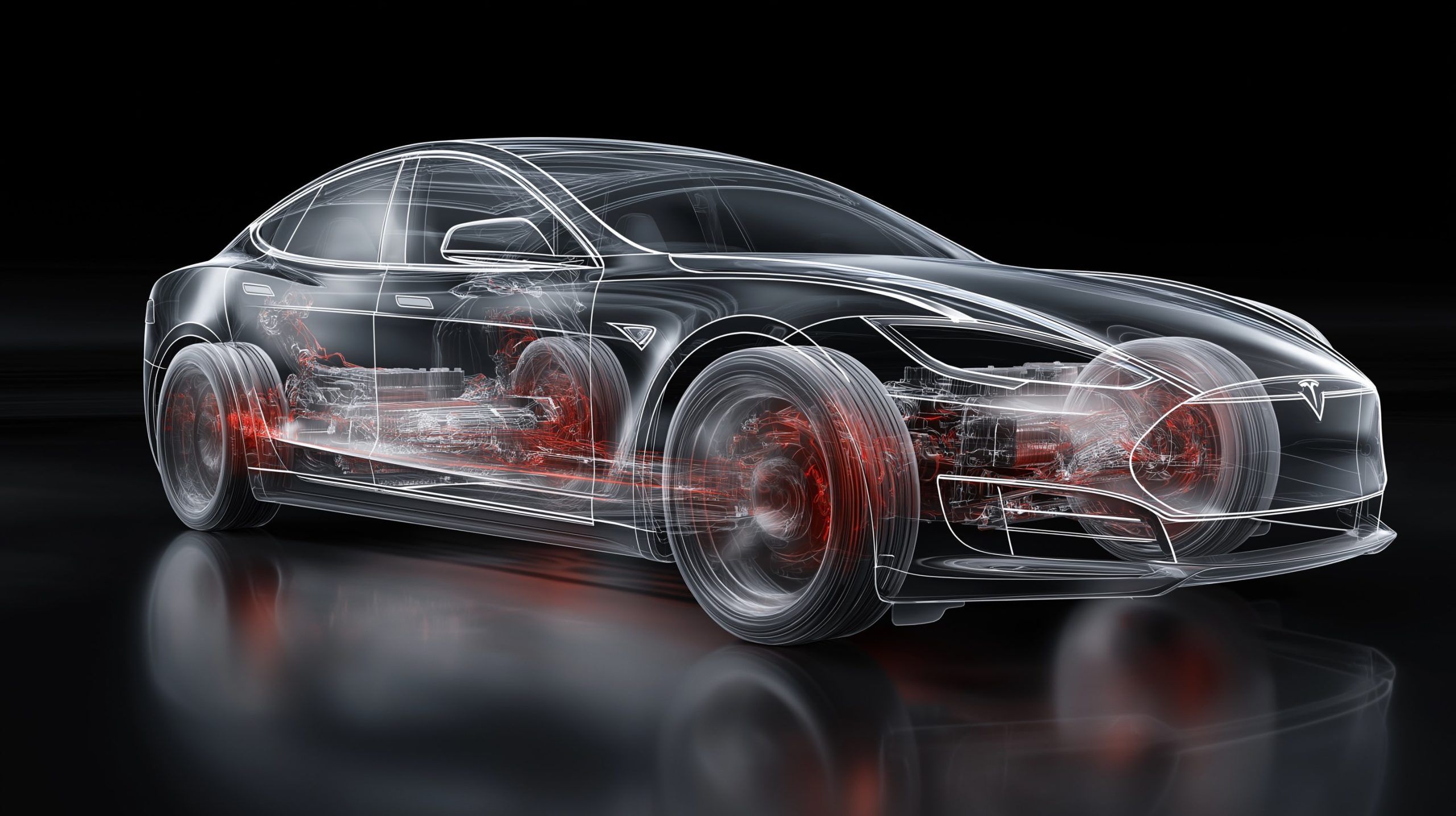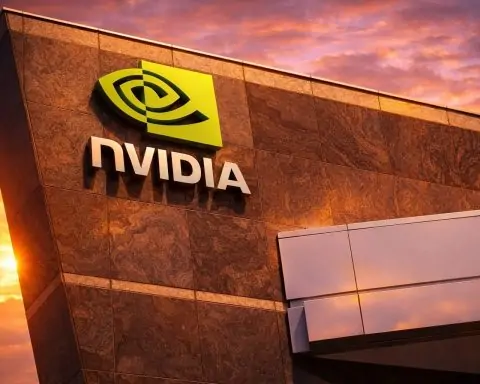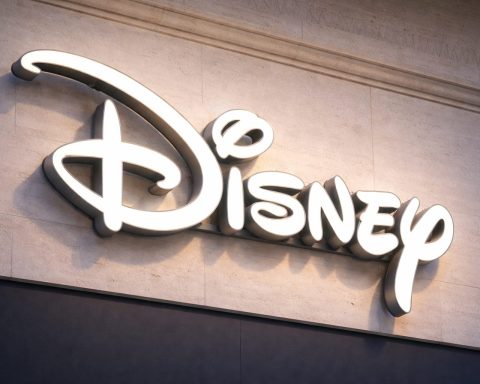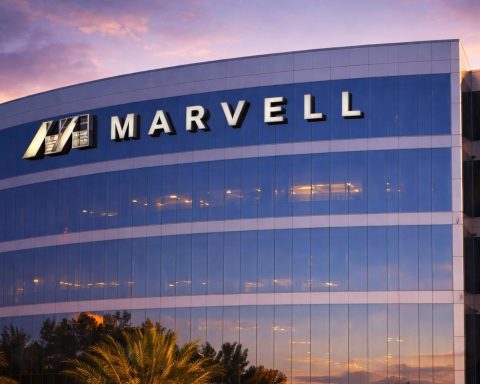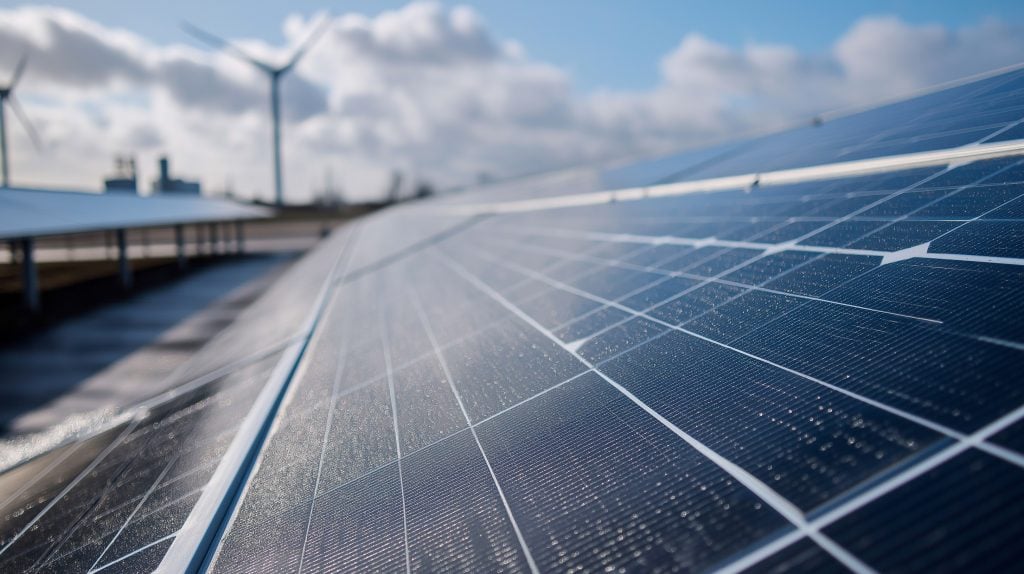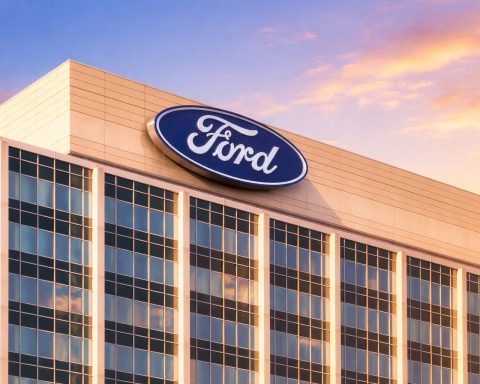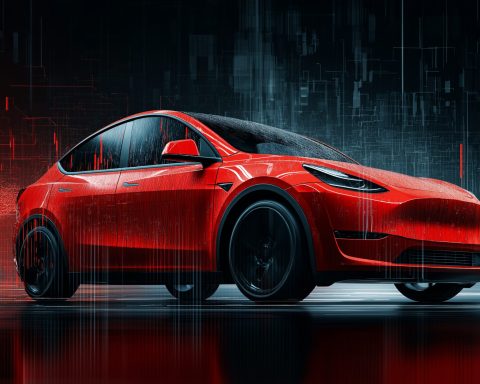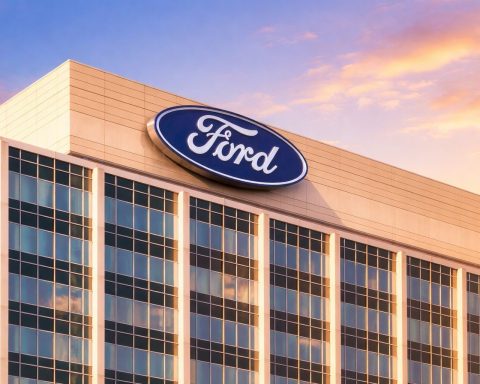- Tesla reaffirmed plans for affordable next-generation EVs on a new platform, with production targeted for the first half of 2025.
- Toyota announced 9 new BEV models for Europe in 2025–2026 (6 Toyota and 3 Lexus) as part of its multi-pathway carbon-reduction strategy.
- Ford unveiled a low-cost EV platform led by a 500-member skunkworks team, with the first vehicle a mid-size electric pickup designed to match Chinese cost structures and a platform that will support up to 8 body styles.
- GM introduced a “layered” Ultium battery design reducing cell count in a pack by up to 75% and unveiled Lithium Manganese Rich (LMR) chemistry to lower costs.
- Hyundai Motor Group announced Integrated Modular Architecture with EM and ES platforms for 2025, with EM delivering roughly 50% more range and Level 3+ autonomy, while ES uses a flexible skateboard for PBVs and a first look at the IONIQ 9.
- Volkswagen Group delayed the SSP rollout to late decade, partnered with Rivian to use its R2 software/tech stack, and co-developed the China EV Architecture with Xpeng to cut costs by about 40% versus MEB, with SSP also including an ICE range-extender option.
- BMW unveiled Neue Klasse with an 800-volt architecture, Gen6 cylindrical cells ~20% higher density, ~30% faster charging, and ~30% more range, plus a pack-to-open-body design and an Energy Master unit; five battery gigafactories across Europe, the US, and China will supply Gen6 cells.
- Stellantis advanced its STLA platforms, with STLA Large testing Factorial solid-state batteries in a Dodge Charger Daytona EV fleet and securing a $7.5 billion DOE loan to build two US battery gigafactories with Samsung SDI.
- Honda cut EV investment by 30% to ¥7 trillion and lowered its 2030 EV share target to about 20%, shifting focus toward hybrids while keeping the Prologue with GM Ultium as its initial EV.
- Market forecasts for May–June 2025 show global EV sales up about 24% year-on-year to roughly 1.6 million in May, with China at 1.02 million and Europe at 330,000, while BloombergNEF projects battery packs around $100/kWh by 2026.
Electric vehicle (EV) powertrains and platforms saw significant news and trends globally during May and June 2025. This report compiles major product launches, technological innovations in EV components, new platform strategies, business moves (partnerships, joint ventures, etc.), market forecasts, and expert commentary from this period. The focus is on credible sources (manufacturer press releases, reputable automotive media, and major outlets) to provide a comprehensive overview.
EV Product Announcements by Automakers (May–June 2025)
Automakers worldwide announced or updated several EV models in this timeframe, signaling both an expansion of EV offerings and adjustments to market demand. Key product announcements include new model launches, refreshes of existing EVs, and strategic shifts in model line-ups:
- Tesla: While no specific new model was officially unveiled in these months, Tesla reiterated that it is preparing to launch affordable “next-generation” EV models starting in 2025. Elon Musk confirmed that development of a lower-cost model (often dubbed the “Model 2” in media) on a next-gen platform remains on track, with production targeted for the first half of 2025 [1]. These affordable models will share aspects of Tesla’s new platform and current vehicle architecture, and Tesla plans to build them on existing assembly lines to accelerate scaling [2]. (Note: By late June 2025, Tesla had not yet publicly revealed these models, but the company indicated they are still “on track” to be unveiled.)
- Toyota: The world’s largest automaker has been slower on pure EVs, but it announced a major EV rollout for Europe. Toyota said it will launch 9 new battery-electric models in Europe in 2025–2026 (six Toyota-brand EVs and three Lexus EVs) [3] [4]. These include new versions of the bZ4X electric SUV, an electric C-HR crossover, and others to expand Toyota’s European EV lineup. Toyota continues to emphasize its “multi-pathway” carbon reduction strategy – balancing EVs with hybrids and plug-in hybrids depending on regional demand [5] [6]. This approach has short-term benefits: Toyota’s hybrids have sold strongly (e.g. in the U.S.), especially as global EV demand showed signs of cooling in some markets in early 2025 [7] [8].
- Ford: Ford revealed new details of its next-generation “low-cost” EV platform aimed at competing with Chinese automakers on affordability [9] [10]. Led by a 500-member “skunkworks” team (including many ex-Tesla/Rivian engineers), this project will underpin a range of accessible EVs. Ford’s first vehicle on the new platform will be a mid-size electric pickup truck (comparable to a Ranger) designed to “match the cost structure of Chinese OEMs” when produced in Mexico [11] [12]. According to Ford EV chief Lisa Drake, the goal is cost parity not just in batteries but across the entire vehicle (chassis, electronics, etc.) [13]. The platform will support up to 8 body styles (trucks, crossovers, maybe sedans) globally and use cheaper LFP battery cells supplied by CATL (with Ford building an LFP cell plant in Michigan) to keep costs down [14]. In short, Ford is gearing up to launch a family of more affordable EVs from 2025 onward that can better compete on price [15].
- General Motors: GM did not introduce a brand-new model in May-June, but made waves with a battery technology announcement. GM outlined a “layered” cell design and new Lithium Manganese Rich (LMR) chemistry that could drastically cut battery cost and weight. Andy Oury, a GM battery engineer, explained that by using prismatic cells and stacking modules differently, GM can reduce the number of cells/modules in a pack by up to 75%, slashing complexity and weight [16] [17]. Simultaneously, GM’s new LMR cathode chemistry will use much more manganese (a cheaper metal) in place of expensive nickel and cobalt, further reducing battery cost without sacrificing performance [18]. This next-gen Ultium battery tech is expected to support GM’s large EVs (e.g. Cadillac Escalade IQ, GMC Hummer) by boosting energy density and affordability [19] [20]. (GM also expanded Cadillac’s EV presence globally – for example, launching Cadillac as an EV-only brand in some markets like Australia [21] – but its technology advancements in batteries were the highlight.)
- Hyundai Motor Group: Hyundai confirmed plans to launch two new dedicated EV platforms in 2025 as a successor to its current E-GMP architecture [22]. Codenamed EM (for passenger cars) and ES (for purpose-built commercial vehicles), these platforms are part of Hyundai’s Integrated Modular Architecture (IMA) strategy to share core components across models [23]. According to Hyundai, the EM platform will be for next-gen Hyundai, Kia, and Genesis electric passenger cars – it promises 50% greater driving range than today’s EVs and will support Level 3 or higher autonomous driving and OTA software updates [24] [25]. The ES platform is designed for “Special Purpose” and commercial EVs (like robotaxis, delivery vans, etc.), using a fully flexible skateboard chassis to accommodate various body configurations for logistics and ride-hailing use cases [26] [27]. Both platforms will heavily standardize components (motors, batteries) under the IMA approach to improve scalability [28]. Hyundai also gave a first glimpse of the upcoming IONIQ 9 flagship EV sedan in this period, highlighting the roomy interior enabled by E-GMP’s flat floor [29], though full details of the Ioniq 9 were not yet released.
- Volkswagen Group: VW’s product news centered on preparing next-generation models and improving current ones. VW officials indicated that the next-generation Golf EV (the electric successor to the Golf) is in development for launch around 2025/26 and will utilize VW’s upcoming advanced platform (the “SSP” Scalable Systems Platform) [30]. In the interim, VW is updating its existing MEB-based models: for example, the ID.4 crossover is slated for a significant 2026 facelift (with reports that it may upgrade from 400V to 800V if the hardware supports it) [31]. Another noteworthy development: VW’s partnership with Rivian (detailed in a later section) implies that future VW-brand EVs may share software and electronic architecture with Rivian’s R2 platform – however, VW will still give each model its own tuning and styling [32]. Also, Porsche (part of VW Group) continued work on high-performance EV tech; industry news in June noted the upcoming electric Porsche Macan and Audi Q6 e-tron (VW Group luxury SUVs due in 2024) will use a PPE platform with an 800V system and a two-speed transmission (similar to the Taycan) to improve high-speed efficiency [33] [34]. This two-speed EV gearbox trend is trickling down to more models, indicating performance EVs are adopting multi-speed transmissions for efficiency gains.
- Chinese OEMs: Automakers in China kept up a rapid cadence of product launches and exports. BYD, China’s EV giant, continued its global expansion in early 2025 – notably, BYD’s overseas sales (e.g. to Southeast Asia, Mexico) surged, helping global EV sales [35]. In its home market, BYD aggressively cut prices on dozens of models in May to defend market share, which boosted sales but also led to rising inventory by June [36] [37]. There were rumors that BYD was testing a new solid-state battery version of its Seal sedan with 1,100+ mile range, but the company publicly denied those rumors in June [38]. Instead, BYD is focusing on proven technologies like its LFP-based Blade Battery and new models such as the Yangwang U8 off-road EV and Seagull city EV (both launched earlier in 2025). Other Chinese EV makers also pushed ahead: for example, Nio began deliveries of its updated ES6 SUV and Xpeng ramped up its G6 crossover – though these specific launches occurred slightly before May. The trend in May–June was Chinese OEMs leveraging price cuts and domestic strength to drive volume (China’s EV sales in May hit a record 1.02 million units) [39] [40], even as competition intensifies.
The table below summarizes select product announcements/updates by major companies in May–June 2025:
| Company | EV Product Announcements / Updates (May–June 2025) |
|---|---|
| Tesla | Reiterated plans for new affordable EV models on a next-gen platform, with production aimed for H1 2025 [41]. (No new model launched in May–June, but Tesla achieved a milestone of an EV self-delivering autonomously to a customer in late June as a tech demo.) |
| Toyota | Announced 9 new BEV models for Europe by 2026 (6 Toyota, 3 Lexus) to expand its EV lineup [42] [43]. Emphasized a mixed strategy (EVs plus hybrids) tailored to each region [44]. |
| Ford | Unveiled a low-cost EV platform strategy led by a 500-member team (ex-Tesla, etc.), targeting Chinese-level cost parity [45] [46]. First product will be a mid-size electric pickup (electric “Ranger”) aiming for radically lower costs [47]. |
| General Motors | Showcased next-gen Ultium battery improvements: a new “layered” module design cutting cell count by up to 75% [48] [49], and high-manganese LMR chemistry to lower cost [50]. These advances aim to boost range and reduce cost in upcoming GM EVs. (Also expanded Cadillac EV offerings to new markets like Australia [51].) |
| Hyundai Group | Confirmed two new EV platforms (EM and ES) for 2025 under its Integrated Modular Architecture [52]. EM for next-gen Hyundai/Kia/Genesis cars with ~50% more range [53]; ES for commercial/PBV EVs with flexible skateboard chassis [54]. Also teased the Ioniq 9 flagship EV sedan (first look), highlighting E-GMP platform benefits. |
| Volkswagen Group | Prepared next-gen EV models and updates: ongoing development of the SSP platform (for 2026+ models like an electric Golf) [55]; partnership with Rivian to use its R2 tech stack in future VW EVs [56]. Planned major refreshes to current ID.3/ID.4 EVs to extend their competitiveness (e.g. ID.4 facelift in 2026 with possible 800V upgrade) [57]. Audi/Porsche (VW subsidiaries) continued work on 800V platforms with 2-speed transmissions for upcoming EVs [58] [59]. |
| BYD (China) | Maintained strong EV sales growth (battery EV sales +40% in first five months) [60] and aggressive pricing (price cuts up to ~$7.4k in May [61]). No new model launch in May–June (after Seagull EV in April), but ramped exports (helped global EV sales hit records) [62]. BYD denied testing solid-state batteries in consumer EVs amid speculation [63], sticking to its commercially proven LFP Blade batteries. |
| Others (China) | Nio, Xpeng, Geely and others continued model rollouts. Example: Nio delivered its new ES6 (two-row SUV) and ET5 Touring in China in May. Xpeng scaled up the new G6 SUV (a Model Y rival). Geely’s Zeekr brand and others also announced new models. These launches underscore China’s rapid EV product cycle, though specific announcements fell slightly outside May–June. |
| Honda | Honda did not launch a new EV in this period; in fact, it announced a strategic shift away from aggressive EV rollout – see “Business Strategies” section. Honda’s Prologue EV (co-developed with GM) is still expected in 2024, but in May 2025 Honda signaled it will focus more on hybrids than expanding its EV lineup [64] [65]. |
(Table Note: This table highlights a selection of announcements. Many automakers also announced minor updates to existing EVs or concept unveilings in this timeframe.)
Innovations in EV Powertrain Components and Technology
May–June 2025 brought a number of technical innovations in motors, batteries, and other EV powertrain components. Automakers and suppliers introduced improvements aimed at increasing performance, efficiency, and reducing costs:
- Next-Generation Batteries: Several breakthroughs in battery tech were reported. General Motors’ battery team revealed a new approach to Ultium batteries using prismatic cells and module “layering” to cut the number of cells/modules by up to 75%, thereby reducing weight and complexity significantly [66] [67]. GM also announced a Lithium Manganese Rich (LMR) battery chemistry with much higher manganese content (a cheaper material) to reduce reliance on costly nickel and cobalt, yielding lower-cost packs with only a minor tradeoff in energy density [68]. In late June, QuantumScape, a startup developing solid-state cells, achieved a milestone by integrating its new “Cobra” continuous-flow separator into pilot production. The Cobra process is a 25× faster ceramic separator manufacturing technique that dramatically improves throughput and reduces equipment footprint for solid-state batteries [69] [70]. This is seen as a step-change in scaling solid-state cell production, bringing QuantumScape closer to commercializing its lithium-metal batteries [71] [72]. On the materials front, a collaboration between chemical giants was reported to develop silicon-anode materials that could enable faster charging [73], indicating ongoing efforts to improve battery charge rates and capacity beyond traditional graphite anodes.
- Solid-State Battery Progress: Solid-state technology made tangible strides. Stellantis and its partner Factorial Energy announced they have validated a high-performance solid-state battery cell and plan to deploy a demonstration fleet of EVs with solid-state batteries by 2026 [74] [75]. Specifically, Stellantis will equip a fleet of Dodge Charger Daytona EVs with Factorial’s FEST solid-state batteries (energy density >390 Wh/kg) as a real-world test before mass production [76]. These cells promise lighter weight and longer range versus today’s Li-ion packs. The demo vehicles will use Stellantis’s new STLA Large EV platform (for performance cars and SUVs) to evaluate solid-state tech under everyday conditions [77]. Stellantis’s CTO Ned Curic stated this is an “important milestone…validating [solid-state’s] potential to enhance our EV lineup with longer range and faster charging” [78]. Similarly, Mercedes-Benz joined the Automotive Cells Company consortium with Stellantis and Total, investing in solid-state and other advanced cell development (as part of ACC’s plans) [79]. These moves show legacy OEMs pushing solid-state batteries from lab to road trials, targeting introduction in the second half of the decade.
- Electric Motors and Drive Units: EV motor technology also advanced. YASA, the UK-based motor maker (owned by Mercedes-Benz), opened a new £12 million factory in Oxfordshire to ramp up production of its axial-flux electric motors [80]. The 60,000 sq.ft. facility can build over 25,000 units annually and is described as the UK’s first “axial-flux motor superfactory,” with cutting-edge processes like CNC coil winding, laser welding, and advanced rotor balancing [81] [82]. Axial-flux motors are compact and high-power – YASA’s expansion suggests these motors will see broader use in performance EVs and hybrids (Mercedes-AMG and Ferrari have used YASA motors in supercars). In motor materials, a partnership between Syensqo and Mavel introduced new high-voltage polymer insulation components for EV motors. They developed PEEK-based slot liners and wire insulation that enable a motor to operate above 800V while improving thermal performance [83]. The thinner insulation allows more copper in the stator, boosting power density and efficiency [84]. This innovation is destined for a premium sports car EV motor, illustrating how materials science is pushing motor voltage and output higher. Another supplier, Eaton, debuted an EV-specific differential (Truetrac) at Auto Shanghai 2025 (reported in May). This limited-slip differential is specially tuned for EVs’ characteristics – it uses helical gears and operates in low-viscosity environments, handling high torque while minimizing noise and drag [85]. Eaton noted the EV Truetrac addresses unique EV challenges like instant torque and quiet operation, leveraging their decades of gear design experience [86]. Meanwhile, magnet-free motor designs are also progressing (ZF won an award in late 2024 for a magnet-free motor, and manufacturers are eyeing them to reduce reliance on rare earth metals).
- Integrated Drive Systems: Automakers are increasingly integrating motor, inverter, and gearbox into compact units. In May, Nidec (a major motor supplier) announced an updated E-axle that improves efficiency by a few percentage points via better inverter silicon-carbide chips (as reported in trade journals). Tesla has been developing a new drive unit with no rare-earth magnets (using a different motor topology), which was first revealed at its 2023 Investor Day – by mid-2025, industry observers noted Tesla’s next-gen drive unit could debut in the upcoming affordable model. While Tesla did not officially announce it in May–June, this magnet-free motor (likely an induction or wound-field design) is expected to cut costs and avoid geopolitical supply risks.
- Charging and Infrastructure Tech: Though outside the vehicle powertrain per se, charging advancements affect the EV ecosystem. In June, BYD announced it will deploy 15,000 ultra-fast chargers (1 MW capable) in China [87]. These DC chargers can add ~400 km of range in just 5 minutes for compatible vehicles, suggesting BYD (and possibly Tesla with its Megacharger for Semi) are pushing charging speeds to new highs. Faster charging impacts battery design (thermal management) and thus is part of powertrain considerations. Additionally, bidirectional charging (V2G/V2L) was highlighted by several OEMs: BMW confirmed its Neue Klasse will have bidirectional charging capability (allowing vehicles to feed energy back to the grid or home) as an option [88], and Nissan expanded its vehicle-to-home pilot programs in June. These features indicate EV powertrains are increasingly being designed as energy platforms as well as mobility devices.
In summary, the past two months saw faster-charging batteries, higher-voltage motors, smarter drivetrains, and the initial practical steps toward solid-state batteries. Many of these innovations aim to increase range and performance (e.g. Factorial solid-state, high-density cells), while others cut costs or improve manufacturability (e.g. GM’s cell design, magnet-free motors). The EV industry in mid-2025 is actively addressing previous limitations – charging time, cost, and efficiency – through rapid technical evolution.
New EV Platform Strategies and Architectures
Automakers are not just launching individual models; they are rethinking the underlying platforms and architectures that will underpin their entire EV portfolios. May–June 2025 featured several significant developments in EV platform strategy:
- Volkswagen’s Multi-Platform Approach: VW has been developing a next-gen unified EV platform called SSP (Scalable Systems Platform) to eventually succeed today’s MEB and PPE platforms. However, in June, it emerged that VW is delaying the SSP platform’s rollout to later this decade (originally expected mid-2020s) due to software development issues at its Cariad division [89] [90]. In the meantime, VW made a surprising strategic partnership: it teamed with Rivian (via a joint venture) to adopt elements of Rivian’s upcoming R2 platform technology stack. Rivian’s Chief Software Officer Wassym Bensaid stated that “R2 is the platform that will underpin all future EV products from VW”, referring to the software and electronic architecture (zonal controllers, ECUs, etc.) that VW will use across its brands [91]. In practice, this means VW’s future EVs (starting perhaps with the electric Golf and T-Roc) will run on Rivian’s electrical/electronic platform and software, while VW will still engineer its own chassis, suspension, and styling for each model [92] [93]. This partnership gives VW access to a modular, scalable electronics and software backbone without waiting for its in-house system, accelerating its EV development. Importantly, VW is still developing SSP for the physical vehicle platform – SSP is intended to be a Group-wide chassis architecture flexible enough for everything from VW to Audi to Porsche. New details confirm SSP will be versatile (able to integrate an ICE range-extender generator for extended range in EVs). VW said the SSP could accommodate a small gasoline engine not to drive the wheels, but as a charging unit (series-hybrid style) – similar to Nissan’s e-Power approach – for markets or segments where charging infrastructure is limited [94]. This “range-extender ICE” would act as a generator to recharge the battery on the go, without mechanical connection to the wheels [95]. It highlights VW’s plan to make SSP truly global – EV-first but adaptable to various use cases. VW also entered a joint venture with Xpeng in China to co-develop a dedicated platform (dubbed China EV Architecture, CEA) for affordable EVs in the Chinese market. This CEA platform is targeted to cut costs by ~40% vs. MEB and produce competitively priced EVs for China. In sum, VW’s platform strategy in mid-2025 is multifaceted: (1) partner with Rivian for software, (2) collaborate with Xpeng for low-cost China models, and (3) continue investing in SSP for the long term, albeit delayed. This underscores how challenging (and crucial) EV platforms are – even the largest automakers are teaming up to get it right.
- Hyundai/Kia’s Integrated Modular Architecture (IMA): Hyundai Motor Group confirmed a major evolution of its EV underpinnings with the introduction of IMA – a common architecture that will spawn at least two new platforms (EM and ES) in 2025 [96]. The EM platform is aimed at next-gen electric passenger cars across Hyundai, Kia, and Genesis brands, and will succeed the current E-GMP. EM-based vehicles will share motors, batteries, and electronic systems as modules. Hyundai says EM will deliver roughly 50% greater range than today’s EVs (thanks to new batteries and efficiencies) [97] and come with built-in support for Level 3+ autonomy and connectivity (OTA upgrades) [98]. Meanwhile, the ES platform will be specialized for commercial and “Purpose-Built Vehicles” (PBVs) – think electric shuttles, robotaxis, cargo vans – using a highly flexible skateboard chassis that can be easily modified for different bodies and purposes [99]. Both EM and ES fall under IMA, meaning they will use a common core set of components (like a standard battery module and motor kit) that can scale to various sizes and uses [100]. The IMA approach is expected to reduce costs and development time as Hyundai scales up EV production. These platforms are set to debut in 2025; for example, an electric Genesis GV90 SUV and next-gen Hyundai/Kia crossovers are rumored to be among the first EM-based models [101] [102]. By committing to IMA, Hyundai is essentially doing what it did successfully with E-GMP, but on a larger, more modular scale, to cover everything from small cars to large commercial trucks in its EV portfolio.
- Tesla’s Next-Gen Platform: Tesla has not fully unveiled its next-gen vehicle platform (often referred to as the basis for a “Model 2” or robotaxi) yet, but during this period the company reiterated its approach to platform evolution. According to Tesla’s statements, the upcoming affordable models will “utilize aspects of the next generation platform as well as aspects of [the] current platforms” [103]. Notably, Tesla plans to build the new models on the same assembly lines as current Models [104] to leverage existing manufacturing efficiencies. This implies Tesla’s next platform is being designed for production flexibility – potentially sharing components like power electronics, steering/suspension parts, etc., with Models 3/Y, even if the core architecture (battery structure, drive units) is new. At its Investor Day (March 2023), Tesla revealed that its next-gen platform will use a 48V low-voltage system, a structural battery pack, and a new drive unit that is no longer reliant on rare-earth magnets. By mid-2025, industry watchers expected Tesla to show this platform soon. Additionally, in late June 2025 Tesla launched a limited robotaxi service in Austin and successfully conducted a fully autonomous vehicle delivery (a new Model Y drove itself from factory to a customer) [105] [106]. These achievements were software-focused, but they underscore Tesla’s platform philosophy: the vehicle hardware and software are tightly integrated to eventually enable self-driving taxis. The next-gen Tesla platform is thus anticipated to support full self-driving hardware, high-efficiency powertrains, and ultra-low-cost manufacturing (Tesla aims to halve production cost per vehicle). While details remain sparse until Tesla’s official reveal, it’s clear Tesla’s platform strategy is about scalability (churning out millions of a mass-market EV) and software capability, rather than offering a multitude of different platforms. We will likely see Tesla’s new platform in action in 2025.
- BMW’s Neue Klasse: BMW is on the cusp of launching its “Neue Klasse” platform, with the first vehicles (a sedan and SUV around 3 Series size) due in 2025. In late June, BMW held a “Tech Day” to showcase the 6th-generation eDrive system that will debut in the Neue Klasse [107] [108]. Key elements of BMW’s new architecture include an 800-Volt electrical system, which enables much faster charging – BMW claims the Neue Klasse will charge 30% faster than its current EVs [109]. Combined with new battery cell technology, Neue Klasse models will also get about 30% more range for the same battery size [110]. BMW confirmed it is switching from prismatic cells to newly developed cylindrical cells for Gen6 batteries, arranged in a “pack-to-open-body” configuration (the battery pack is a structural floor element) with cell-to-pack integration (no modules) [111] [112]. The new cylindrical cells have ~20% higher energy density than BMW’s previous prismatic cells [113]. BMW also designed a sophisticated Energy Management unit (“Energy Master”) that sits atop the pack and controls high-voltage distribution, battery safety, and even bidirectional charging features [114]. Another notable aspect: BMW is adopting a “technology-open” motor strategy – the Neue Klasse will use both EE synchronous motors (externally excited, no magnets) and induction motors, depending on model, rather than only permanent-magnet motors [115] [116]. This flexibility (using no-rare-earth motor types) can help BMW avoid material supply issues and optimize for cost or performance as needed. Finally, BMW’s platform production is being localized: it is building 5 battery gigafactories on 3 continents (Europe, China, US) with partners to supply Gen6 cells, and new assembly plants (Hungary, Mexico, USA, etc.) for Neue Klasse vehicles [117] [118]. Overall, the Neue Klasse represents a ground-up redesign for BMW – structural battery, unified platform for all models, vastly improved batteries and electronics – aimed at closing the gap with Tesla in efficiency and cost. Early indications (466-mile range concept, new UI/UX with MB.OS-like software) suggest BMW is confident this platform will underpin its EV resurgence from 2025 forward.
- Stellantis STLA Platforms: Stellantis (parent of 14 brands including Jeep, Peugeot, Dodge) is in the process of rolling out its family of STLA platforms (Small, Medium, Large, Frame). In this period, Stellantis’s platform news revolved around enhancements to STLA Large. As mentioned, STLA Large is being used to test Factorial’s solid-state batteries [119], showing it was designed with future battery upgrades in mind. STLA Large will underpin many 2025–26 EVs (e.g. the coming Dodge Charger Daytona SRT EV, Jeep Wagoneer S, etc.) and is said to support up to 2 million vehicles/year across brands [120]. In Europe, Stellantis is deploying STLA Medium for compact/mid EVs like the Peugeot e-3008. By mid-2025, Stellantis also hinted at exploring range extender solutions for certain markets – the CEO of Citroën mentioned investigating small onboard generators (similar to what VW described and what Nissan e-Power uses) for regions like Africa where charging is scarce. Another strategic move: Stellantis and the French research body CEA formed a partnership to develop high-energy-density battery cells and manufacturing processes [121], ensuring its platforms will benefit from cutting-edge cells by late decade.
The table below highlights how some major companies advanced their EV platform strategies in May–June 2025:
| Company | Platform Strategy Developments (May–June 2025) |
|---|---|
| Volkswagen Group | Delayed its new SSP platform to late-decade due to software issues [122]. Instead, partnered with Rivian: future VW EVs will adopt Rivian’s “R2” software/tech stack (shared electronics architecture) while retaining unique chassis/branding [123]. Also co-developing a low-cost China-only EV platform (CEA) with Xpeng to cut costs ~40% vs. MEB. Revealed SSP will support an ICE range-extender (generator) option for extended range EVs [124]. |
| Hyundai Motor Group | Announced Integrated Modular Architecture (IMA) with two new platforms: EM for all passenger EVs, ES for commercial/PBV, starting 2025 [125]. EM promises ~50% longer range and Level 3 autonomy support [126]; ES provides a flexible skateboard for shuttles/vans [127]. Both use standardized motors/batteries to reduce complexity [128]. IMA is next-gen evolution of E-GMP for Hyundai/Kia/Genesis. |
| Tesla | Reiterated its next-gen EV platform for a high-volume affordable model. Plans to integrate new platform models into existing factories/lines (for efficiency) [129]. Next-gen design to use some current components but also new innovations (e.g. 48V system, structural pack, magnet-free motor – per earlier Tesla disclosures). Emphasis on manufacturability at scale and full-self-driving capability. (Expected reveal late 2025; no new platform launched yet.) |
| BMW | Unveiled details of the Neue Klasse platform: implementing 800V architecture, Gen6 cylindrical cells (20% higher energy density) in a structural pack [130]. Claimed 30% faster charging and 30% more range vs. Gen5 [131]. Modular motor strategy using both magnet-less and induction motors [132]. Localizing production with battery plants in EU/US/China. First Neue Klasse EVs to start production in late 2025 [133] [134]. |
| Stellantis | Progressing its STLA platforms (Small/Medium/Large/Frame). In H1 2025, preparing STLA Large to launch (for Dodge, Jeep, etc.) and planning a 2026 solid-state battery fleet on STLA Large with Factorial’s cells [135] [136]. Also secured a $7.5B U.S. DOE loan (announced May) for joint-venture battery plants with Samsung SDI [137], to supply its platforms. Focus on flexible platform design (e.g. STLA Frame for electric pickups like Ram 1500 REV). |
| Ford | Developing a new dedicated EV architecture for low-cost models, separate from the current GE1 (Mach-E) and TE1 (F-150 Lightning) platforms. Ford’s new platform (sometimes called “Project T3” for the truck variant) will support 8 different models including a mid-size pickup, crossovers, etc. [138]. Emphasizing extreme cost reduction (using LFP batteries, simplified chassis) to compete globally [139] [140]. First vehicles on it expected ~2026. |
| Toyota | Continues to refine its multi-path strategy. In 2025, Toyota’s EVs still use the e-TNGA platform (co-developed with Subaru) for models like bZ4X. However, Toyota is reportedly fast-tracking a new dedicated EV architecture for after 2026, including use of gigacasting and next-gen batteries [141]. In June, Toyota got government approval to start making solid-state batteries in Japan by 2027 as part of its next-gen EV program [142]. Toyota aims to streamline EV development to catch up (recently created a specialized EV unit under its new CEO). |
| Honda | Shift in strategy: Honda in May said it will scale back pure EV plans (targeting 20% EV sales by 2030 instead of 30%) and refocus on hybrids [143] [144]. Its previously intended dedicated EV platform (e:Architecture) for the late-2020s may be delayed. In near term, Honda is relying on GM’s Ultium platform for its first two EVs (Prologue and Acura ZDX). Honda’s platform strategy is now in flux given its reduced EV spending and emphasis on next-gen hybrid systems. |
As the table indicates, automakers are pursuing a mix of strategies – some doubling down on clean-sheet EV platforms (Hyundai IMA, BMW Neue Klasse), others choosing collaborative approaches (VW with Rivian and Xpeng), and some even tapping the brakes on EV-only plans (Honda, and even Toyota to a degree). A common theme is modularity and scalability: nearly every company is aiming to use a few core platforms to cover many vehicle segments, to maximize volume and reduce cost per unit. Additionally, many platforms are being designed with future-proofing in mind – e.g. compatibility with solid-state batteries, 800V charging, advanced driving aids, and even the ability to incorporate range extenders or hybrid variants if needed. These platform decisions made in 2025 will shape the competitive landscape of EVs for the second half of the decade.
Business Strategies, Partnerships, and Industry Moves
Beyond technical developments, the EV sector in May–June 2025 saw important business and strategic decisions by automakers and suppliers. These include joint ventures, investments, policy responses, and shifts in market strategy:
- Joint Ventures & Partnerships: Traditional OEMs continued partnering with new players to access technology or new markets. A notable example is Mitsubishi Motors signing an MOU with Foxconn’s EV arm (Foxtron) in May. Under this agreement, Foxtron will develop and manufacture an EV for Mitsubishi – built in Taiwan by Yulon Motors – which Mitsubishi will sell in markets like Australia/New Zealand from 2026 [145] [146]. This kind of partnership shows smaller automakers leveraging contract manufacturers and existing EV platforms (Foxtron’s) to expand their EV lineup with lower investment. Volkswagen–Rivian (as discussed) is another unconventional alliance, marrying an old-world OEM with a startup’s software expertise [147]. Ford and CATL deepened their collaboration by moving forward (amid political scrutiny) on Ford’s LFP battery plant in Michigan, using CATL tech – a $3.5B project aimed to supply low-cost batteries from 2026 [148] [149]. In Europe, Mercedes-Benz joined Stellantis and TotalEnergies as an equal partner in the Automotive Cells Company (ACC) venture to co-develop and produce battery cells, underlining the trend of automakers investing directly in battery consortia [150].
- Investments and Acquisitions: Automakers continued to invest in the EV supply chain. Stellantis, for instance, secured a massive $7.5 billion loan from the U.S. Department of Energy in June to help build two U.S. battery gigafactories with Samsung SDI [151]. This will bolster Stellantis’s North America battery capacity for its STLA platforms. Magna International (a major supplier) announced it would acquire a Veoneer division specializing in e-drive software, to enhance its EV component offerings (reported by Automotive News in June). Bosch completed its acquisition of U.S. chipmaker TSI Semiconductors to boost silicon carbide chip production for EV inverters – an important move as SiC-based inverters are key to improving efficiency. Meanwhile, Redwood Materials (a battery recycling startup) entered partnerships with Volkswagen Group and Audi in June to recycle end-of-life EV packs in the US, reflecting automakers’ focus on securing materials in a sustainable loop. On the startup front, VinFast from Vietnam inaugurated a second factory (in Ha Tinh, Vietnam) on June 29 to ramp up output of its affordable EVs [152], after its IPO in 2023 – signaling new entrants scaling up to challenge incumbents.
- Market Strategy Shifts: Some automakers revised their EV sales targets and product mix in response to market conditions. Honda is the clearest example – on May 20, Honda’s CEO Toshihiro Mibe announced a scale-back of Honda’s EV ambitions, citing uncertain demand [153] [154]. Honda cut its planned investment in EVs and software by 30% (to ¥7 trillion) and dropped its goal of 30% EV sales by 2030, now expecting only ~20% EV mix by 2030 [155]. Instead, Honda will double-down on what it’s strong at: hybrids. It plans to launch 13 new hybrid models from 2027-2030 and even develop new large-vehicle hybrid systems [156] [157]. This pivot is because hybrids are “far more in favor” with consumers than pure EVs at the moment, Mibe noted [158] [159]. Honda’s retrenchment is one of several instances of companies adjusting EV plans: a Reuters analysis pointed out that multiple carmakers are “dialling back” EV investment due to slower-than-expected uptake and regulatory changes [160] [161]. Similarly, in late April Volvo Cars said it would likely keep hybrids past 2030 instead of going 100% EV [162]. In the U.S., Ford and GM both decided to slow the pace of new EV introductions – Ford in May delayed a second EV truck model, and GM in late June was reported to be re-evaluating EV production targets (though officially still committed to growth). BYD, despite huge EV sales, took an unexpected step of temporarily slowing production in Q2 2025: Reuters reported BYD cut back shifts and postponed some capacity expansion in China, after inventory piled up due to aggressive output and a fierce price war [163] [164]. BYD’s output in April–May 2025 grew only ~0–13% YoY (much slower than prior) and the company canceled some night shifts [165] [166]. BYD’s management reportedly initiated these measures to save costs and avoid oversupply after price cuts didn’t fully translate to expected sales gains [167]. This illustrates even market leaders must modulate production in a competitive, price-sensitive environment.
- Policy and Regulatory Factors: Government policies directly influenced strategies. In the U.S., the shifting political winds saw President Trump revoke a 2021 executive order that aimed for 50% EV sales by 2030 (he did so in early 2025) [168]. This policy reversal, along with potential removal of EV subsidies by some lawmakers, made automakers cautious about over-committing to EV volume in North America. (Honda’s CEO explicitly referenced that governments “ease timelines” for EV targets as a reason to adjust strategy [169].) In Europe, new fleet purchase incentives in countries like Germany were introduced to stimulate EV demand in H2 2025 [170] [171]. Automakers like Stellantis and Renault welcomed these moves as they have many new EV models launching in Europe (where CO₂ targets still tighten in 2025–2030 despite some delays on combustion engine bans). China, on its part, extended EV purchase incentives in some cities and continued a subsidy for rural EV buyers, which benefits domestic makers like BYD and Nio (and helped China’s EV sales hit record levels in May [172]). Thus, companies are aligning their business moves with the policy landscape: investing in regions where subsidies and infrastructure support EV growth, and hedging bets (with hybrids or range-extenders) where government or consumer support is weaker.
All told, the business environment in mid-2025 reflects a balancing act: automakers are investing heavily in EV tech and partnering up to fill capability gaps, yet they are also pragmatically adjusting targets and product mix based on real-world demand and policy signals. Joint ventures (whether for technology, manufacturing, or battery supply) are becoming commonplace, as no single company can efficiently do everything in-house in the EV era. We are also witnessing some consolidation – weaker EV startups are struggling in price wars (e.g. smaller Chinese EV brands were threatened by BYD’s cuts [173] [174]) and legacy firms focusing on their strengths (Honda on hybrids, Toyota on a diversified approach). The next 18 months will be critical as these strategic choices play out in the marketplace.
Market Forecasts and EV Adoption Trends
During May–June 2025, analysts and industry observers provided fresh forecasts and analysis of EV demand, costs, and adoption trends. Several reports and executive comments painted a nuanced picture of the global EV market:
- Global EV Sales Growth: EV sales continued to grow in 2025, but unevenly across regions. Data from Rho Motion showed that global sales of electric vehicles (including plug-in hybrids) rose about 24% in May 2025 year-over-year, reaching approximately 1.6 million units for the month [175] [176]. The growth was heavily driven by China: Chinese EV sales hit 1.02 million in May, up ~24%, marking the first time in 2025 that China exceeded 1 million EVs in a single month [177] [178]. Europe also saw robust EV growth – around 330,000 EVs sold in Europe in May, up 36% YoY [179], aided by incentives and a slew of new models. North America, however, showed only +7.5% growth (to ~160,000 units in May) [180], indicating a plateauing trend. Charles Lester, an analyst at Rho Motion, highlighted “the continued chasm between Chinese market growth versus the faltering market in North America” as the key story – China’s EV demand is surging, whereas North America’s is lagging expectations [181]. Factors for North America’s slower growth include the phase-out of some subsidies (e.g. Canada’s EV incentive expiry hurt sales in that market) [182] and possibly consumer hesitation as U.S. EV tax credit rules change and fuel prices stay moderate [183] [184]. The global EV market share (new sales) stood around 18% in 2025 (higher in Europe ~20%+, and China ~30%, but lower in US ~8-9%). Analysts generally forecast that global EV sales would surpass 14 million units in 2025 (up from ~10.5 million in 2023), but they cautioned that growth might be “front-loaded” in China and slower elsewhere if economic conditions tighten.
- Cost and Price Trends: Many industry experts in mid-2025 pointed out that EV production costs are under pressure, and achieving price parity with combustion vehicles is crucial for the next wave of adoption. Ford’s strategy discussions (with analyst Daniel Roeska) noted that leading Chinese EV makers had achieved remarkably low costs, and Ford openly set a goal to match those costs for its next-gen models [185] [186]. This implies a selling price in the mid-$20k range for a compact EV is needed to truly mass-market EVs – a target several companies (like BYD with its Dolphin/Seagull, or MG with its MG4) are already hitting in China and Europe. BloombergNEF, in a June brief, projected that average battery pack prices, which rose in 2022, would resume their decline in 2025 thanks to LFP chemistry and scaled production – reaching around $100/kWh by 2026. If realized, that would significantly lower EV costs. Conversely, raw material volatility (lithium, etc.) remains a risk; however, by June lithium prices had fallen from 2022 peaks, easing pack costs. An emerging trend is automakers offering cheaper, shorter-range variants using LFP batteries to hit lower price points (e.g. Tesla’s Model 3 with an LFP pack, or VW planning LFP options on entry models). These moves are expected to broaden EV adoption among cost-conscious buyers.
- Market Sentiment & Consumer Demand: There is a sense of bifurcation in demand. In China and Europe, competition and choice are accelerating EV adoption – Chinese consumers have dozens of affordable EV options, driving EV penetration above 30% of new sales. In North America, consumer surveys (from JD Power and others) in mid-2025 showed interest in EVs had plateaued or even dipped among some groups, mainly due to concerns about price, charging infrastructure, and the rollback of government support. For example, the removal of a U.S. proposal to mandate 50% EVs by 2030 (under the Trump administration) and constant headlines about EV price wars might have signaled to some consumers that waiting could yield a better deal. This “EV hesitancy” in the U.S. led companies like Honda to temper their projections – “It’s really hard to read the market,” Honda’s CEO said, explaining why they now foresee only ~20% EV mix by 2030 in their sales [187] [188]. Still, it’s worth noting the overall trajectory remains toward electrification; even Honda’s lowered target is a tenfold increase from its current 2% EV mix. Analysts expect a potential inflection around 2025–2026 as more sub-$30k EVs hit the market and charging networks expand, which could re-accelerate adoption especially in North America.
- Expert Commentary: Executives and analysts offered notable quotes during this period. A few examples: Ford’s CEO Jim Farley, after test-driving a Chinese EV (the Xiaomi MS11 sedan), remarked on a podcast that it was “fantastic” and that “you’ve got to get behind the wheel to truly understand and beat the competition”, implicitly urging Western automakers to experience how far Chinese EVs have come [189]. This underscores why Ford formed its skunkworks team to tear down cost – China’s EVs are the benchmark in efficiency and value. From the supplier side, Bosch’s VP for EV systems in a June interview highlighted that nearly every new EV platform now requests 800V components and silicon-carbide inverters, showing a rapid tech adoption that is shortening product cycles. In Europe, Monika Schnitzer (head of the German Council of Economic Experts) commented in May that “the EV transition is irreversible, but it won’t be linear”, referencing that EV sales might face ups and downs with economic conditions, yet the investment momentum guarantees that by 2030 an EV will simply be the better car in most cases. Meanwhile, Tesla’s Elon Musk struck an upbeat tone on demand (noting that *once a person buys one EV, they are highly likely to make their next car electric too – “86% of first-time EV buyers stick with EVs” he tweeted, citing internal data [190] [191]). This suggests a strong conversion loyalty: as more people try EVs, the addressable market organically grows via word-of-mouth and repeat buyers.
- Infrastructure and Policy Outlook: Looking ahead, forecasts incorporate the effect of infrastructure build-out. The IEA’s mid-2025 outlook projected that by 2030 there would be over 50 million public charging points worldwide (up from ~2 million in 2022), thanks to heavy investment in China, the EU, and the US (through the NEVI program). Government targets were adjusted in some places – for instance, the EU’s proposed 2035 ICE ban remained, but countries like Germany obtained concessions for e-fuel cars. Analysts think such policies may slightly slow EV adoption in niche segments, but mass market trends (and fleet emissions rules) still strongly favor EVs. In the US, the EPA’s proposed 2027–2032 vehicle emissions standards (announced in April 2025) could effectively require ~60% EV sales by 2030 to comply – though litigation and a new administration stance create uncertainty. Automakers are thus navigating a patchwork of regulations: tightening in Europe and (potentially) the US (depending on politics), versus supportive industrial policy in China. The consensus of forecasts is that EV adoption will continue to rise through 2025 and beyond, but the trajectory might not be a smooth exponential curve; it will be influenced by vehicle affordability, macro-economic conditions, and consumer confidence in the technology.
In summary, by mid-2025 the EV market is in a complex phase: global sales are reaching new highs, yet growth is uneven, and some automakers are re-calibrating short-term expectations even as they invest for the long term. The next two years (2025–2026) are expected to bring a wave of new models and cheaper batteries that could re-energize consumer demand – a point echoed by multiple experts. The overall trend remains that EVs will continue gaining market share each year (with one firm predicting EV/PHEV sales will exceed 20 million in 2026 globally), but as Honda’s CEO said, “it’s really hard to read the market” in the immediate term [192]. Automakers are therefore hedging: pushing forward with electrification, yet ready to adjust the mix (with hybrids, range extenders, pricing strategies) to match what customers are willing to buy in each region. The developments of May and June 2025 capture this dynamic moment in the EV transition, with exciting technological progress on one hand and pragmatic business reality checks on the other.
Sources:
- Company press releases and investor presentations (Toyota [193] [194], Mitsubishi [195] [196], Hyundai [197] [198], Ford [199] [200], GM [201] [202], BMW [203] [204], Stellantis/Factorial [205] [206], etc.)
- Reputable news outlets: Reuters (global EV sales and automaker strategy updates [207] [208] [209] [210]), Electrek (Ford cost platform [211], BYD news [212]), InsideEVs and Automotive News for industry analysis.
- Expert quotes and analysis: statements from Honda CEO Toshihiro Mibe [213], Ford VP Lisa Drake via Axios [214], Rho Motion analyst Charles Lester [215], and others as cited above.
References
1. www.teslarati.com, 2. www.teslarati.com, 3. www.reuters.com, 4. www.reuters.com, 5. www.reuters.com, 6. www.reuters.com, 7. www.reuters.com, 8. www.reuters.com, 9. electrek.co, 10. electrek.co, 11. electrek.co, 12. electrek.co, 13. electrek.co, 14. electrek.co, 15. electrek.co, 16. www.carsguide.com.au, 17. www.carsguide.com.au, 18. www.carsguide.com.au, 19. www.carsguide.com.au, 20. www.carsguide.com.au, 21. www.carsguide.com.au, 22. www.chasingcars.com.au, 23. www.chasingcars.com.au, 24. www.chasingcars.com.au, 25. www.chasingcars.com.au, 26. www.chasingcars.com.au, 27. www.chasingcars.com.au, 28. www.chasingcars.com.au, 29. www.hyundainews.com, 30. www.carscoops.com, 31. www.carsales.com.au, 32. www.carscoops.com, 33. insideevs.com, 34. insideevs.com, 35. www.reuters.com, 36. carnewschina.com, 37. www.reuters.com, 38. electrek.co, 39. www.reuters.com, 40. www.reuters.com, 41. www.teslarati.com, 42. www.reuters.com, 43. www.reuters.com, 44. www.reuters.com, 45. electrek.co, 46. electrek.co, 47. electrek.co, 48. www.carsguide.com.au, 49. www.carsguide.com.au, 50. www.carsguide.com.au, 51. www.carsguide.com.au, 52. www.chasingcars.com.au, 53. www.chasingcars.com.au, 54. www.chasingcars.com.au, 55. www.carscoops.com, 56. www.carscoops.com, 57. www.carsales.com.au, 58. insideevs.com, 59. insideevs.com, 60. electrek.co, 61. carnewschina.com, 62. www.reuters.com, 63. electrek.co, 64. www.reuters.com, 65. www.reuters.com, 66. www.carsguide.com.au, 67. www.carsguide.com.au, 68. www.carsguide.com.au, 69. www.quantumscape.com, 70. www.quantumscape.com, 71. www.quantumscape.com, 72. www.quantumscape.com, 73. www.electrichybridvehicletechnology.com, 74. www.electrichybridvehicletechnology.com, 75. www.electrichybridvehicletechnology.com, 76. www.electrichybridvehicletechnology.com, 77. www.electrichybridvehicletechnology.com, 78. www.electrichybridvehicletechnology.com, 79. moparinsiders.com, 80. www.electrichybridvehicletechnology.com, 81. www.electrichybridvehicletechnology.com, 82. www.electrichybridvehicletechnology.com, 83. www.electrichybridvehicletechnology.com, 84. www.electrichybridvehicletechnology.com, 85. www.electrichybridvehicletechnology.com, 86. www.electrichybridvehicletechnology.com, 87. thedriven.io, 88. www.press.bmwgroup.com, 89. auto.hindustantimes.com, 90. auto.hindustantimes.com, 91. www.carscoops.com, 92. www.carscoops.com, 93. www.carscoops.com, 94. auto.hindustantimes.com, 95. auto.hindustantimes.com, 96. www.chasingcars.com.au, 97. www.chasingcars.com.au, 98. www.chasingcars.com.au, 99. www.chasingcars.com.au, 100. www.chasingcars.com.au, 101. www.kedglobal.com, 102. www.kedglobal.com, 103. www.teslarati.com, 104. www.teslarati.com, 105. www.teslarati.com, 106. www.teslarati.com, 107. www.press.bmwgroup.com, 108. www.press.bmwgroup.com, 109. www.press.bmwgroup.com, 110. www.press.bmwgroup.com, 111. www.press.bmwgroup.com, 112. www.press.bmwgroup.com, 113. www.press.bmwgroup.com, 114. www.press.bmwgroup.com, 115. www.press.bmwgroup.com, 116. www.press.bmwgroup.com, 117. www.press.bmwgroup.com, 118. www.press.bmwgroup.com, 119. www.electrichybridvehicletechnology.com, 120. www.electrichybridvehicletechnology.com, 121. www.automotivetestingtechnologyinternational.com, 122. auto.hindustantimes.com, 123. www.carscoops.com, 124. auto.hindustantimes.com, 125. www.chasingcars.com.au, 126. www.chasingcars.com.au, 127. www.chasingcars.com.au, 128. www.chasingcars.com.au, 129. www.teslarati.com, 130. www.press.bmwgroup.com, 131. www.press.bmwgroup.com, 132. www.press.bmwgroup.com, 133. www.press.bmwgroup.com, 134. www.press.bmwgroup.com, 135. www.electrichybridvehicletechnology.com, 136. www.electrichybridvehicletechnology.com, 137. www.ttnews.com, 138. electrek.co, 139. electrek.co, 140. electrek.co, 141. www.greencarreports.com, 142. www.reuters.com, 143. www.reuters.com, 144. www.reuters.com, 145. www.mitsubishi-motors.com, 146. www.mitsubishi-motors.com, 147. www.carscoops.com, 148. electrek.co, 149. electrek.co, 150. moparinsiders.com, 151. www.ttnews.com, 152. evxl.co, 153. www.reuters.com, 154. www.reuters.com, 155. www.reuters.com, 156. www.reuters.com, 157. www.reuters.com, 158. www.reuters.com, 159. www.reuters.com, 160. www.reuters.com, 161. www.reuters.com, 162. www.reuters.com, 163. www.reuters.com, 164. www.reuters.com, 165. www.reuters.com, 166. www.reuters.com, 167. www.reuters.com, 168. www.reuters.com, 169. www.reuters.com, 170. www.reuters.com, 171. www.reuters.com, 172. www.reuters.com, 173. www.carsguide.com.au, 174. carnewschina.com, 175. www.reuters.com, 176. www.reuters.com, 177. www.reuters.com, 178. www.reuters.com, 179. www.reuters.com, 180. www.reuters.com, 181. www.reuters.com, 182. www.reuters.com, 183. www.reuters.com, 184. www.reuters.com, 185. electrek.co, 186. electrek.co, 187. www.reuters.com, 188. www.reuters.com, 189. electrek.co, 190. www.carsguide.com.au, 191. www.carsguide.com.au, 192. www.reuters.com, 193. www.reuters.com, 194. www.reuters.com, 195. www.mitsubishi-motors.com, 196. www.mitsubishi-motors.com, 197. www.chasingcars.com.au, 198. www.chasingcars.com.au, 199. electrek.co, 200. electrek.co, 201. www.carsguide.com.au, 202. www.carsguide.com.au, 203. www.press.bmwgroup.com, 204. www.press.bmwgroup.com, 205. www.electrichybridvehicletechnology.com, 206. www.electrichybridvehicletechnology.com, 207. www.reuters.com, 208. www.reuters.com, 209. www.reuters.com, 210. www.reuters.com, 211. electrek.co, 212. electrek.co, 213. www.reuters.com, 214. electrek.co, 215. www.reuters.com
